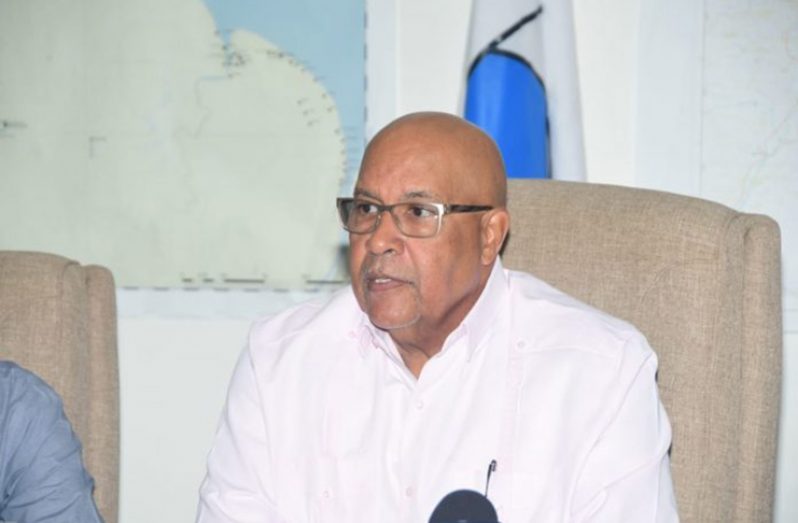WITH Guyana firmly projected to experience economic and population growth over the next few years, many public physical infrastructures would require upgrading. On its part, the Guyana Water Inc (GWI) is leading the way in improving the country’s sewage system.
The utility has begun design of waste water treatment plants for Georgetown’s existing sewage system, with hopes that construction can begin before the end of 2020. It is also hoping to begin discussions with the Ministry of Communities (MoC) for the establishment of network sewage systems across Guyana’s other nine municipalities, as well as developing housing schemes.
“If we can make some shift from septic tanks to treatment plants within these housing schemes then it will be a better place,” said GWI Managing Director, Dr. Richard Van-West Charles.
He added: “Our remit on the books gives us Georgetown but we’ve had discussions with the MoC because of the new towns that are emerging, that GWI will collaborate with the RDCs (Regional Democratic Councils) in looking at the new towns and also the new housing schemes.”
Georgetown is currently Guyana’s only area with a municipal sewage network, in other parts of the country citizens utilise ‘on site waste water treatment’ which are regularly referred to as septic tanks. Pit latrines are also used by some.
The establishment of other sewage networks across the country would not necessarily need to be as extensive as creating conventional sewage network, as there is a simpler option that would incorporate the use of extant septic tanks.
“There are small-bore waste water treatment network. It involves the use of small pipelines as small as an inch in diameter. If we go for small bore system, it can be pretty simply and pretty fast,” explained GWI Sanitation Manager, Rensford Joseph.
“With the small bore system, the primary treatment is done at the customers’ home. One type of small bore system is the conventional septic tank with the flow system at the end. We connect it through a filtration system that traps all of the solids, and what comes out is water that can now be taken to the secondary treatment plant.”
According to reports, the small-bore sewer system could cost up to 50 per cent less than conventional sewerage.
MORE EXPENSIVE
“With the conventional sewage system, the primary, secondary and tertiary treatments are all done at one compound. The conventional system is more expensive, more timely, the maintenance cost will be greater as against the small bore system, where the maintenance is very low, the time for construction would be shorter and requires less land for the installation of the network and the plant itself. There is no need for pump stations, no need for man holes,” Joseph noted.
He added: “The disadvantage of that is the septic tanks may require cleaning far sooner than the conventional system because all of the solids are left in the septic tank system. That’s about the only disadvantage.”
In Georgetown, the sewage system encompasses 24 sewerage pumping stations within Central Georgetown and a septic receiving station at Tucville that receives sewage from a network within the Tucville-Stevedore Housing Schemes.
The Central Georgetown system was first commissioned in 1929 while the Tucville sewage system was constructed in 1970. In the first quarter of 2020, GWI is expected to pilot a remote monitoring system to predict blockages on the sewer distribution system.
Waste water from neither of the two systems is being treated so the company is looking to have treatment facilities established for both systems.
“Before we can begin construction, we need the data to determine the size of the plant that is necessary, based on the volume of waste water generated,” explained Joseph.
“The gathering of data takes a long period because you have to gather data across both wet and dry seasons, so we need data across at least 18 months, which would tell us how much rainfall is going to happen in Guyana over a period, as well as what is the length of the dry season. We also have to gather data on the waste water characteristics; we have to look at information such as Biological Oxygen Demand (BOD), Chemical Oxygen Demand (COD), Total Suspended Solid (TSS). We also need to get information as it relates to the leachate in the waste water, information such as total phosphorus, total ammonia and total nitrogen. When we get that information we put that into calculations which will allow us to determine the size of waste water plant necessary, and also the best technology for the type of waste we are treating.”
The company installed flow meters in the Georgetown system which allowed for the collection of the necessary data. The cost for the facility would be determined after other aspects of the plants are decided.
GATHERING INFORMATION
“We are still in the process of gathering but we have information to begin designing, so it would be safe to say that we will begin construction before the end of 2020. I cannot give a cost because we have not yet determined the size and the technology that we will be applying,” Joseph related.
“Our first treatment plant is likely to be the Tucville system, which was a waste water treatment plant, so we’re more or less re-engineering it so that it can become a waste water treatment plant once again, and at the same time we are working on a waste water plant for the Georgetown sewage system.”
Treatment of waste water is necessary for the protection of the environment and population.
“It has a lot of pathogens, viruses, bacteria and that can be harmful to the environment, both for land use and marine environment. It can cause environmental degradation; it can affect public health and the marine environment. Also we’re discharging waste with a lot of leachate which can cause algae boom, or eutrophication, which is the rapid growth of weed like what we see happening in trenches,” Joseph said.
Currently, in Georgetown, the “untreated” flows are discharged to the mouth of the Demerara River via short outfall at Fort Groyen, Kingston. The risks are not currently great; however, this could change as the population expands.
“We are currently discharging into the Atlantic Ocean and there’s no adverse effect because it’s a small volume of waste into a large volume of water. We call it preventing pollution through dilution,” Joseph explained.
“The dilution factor is around one litre of sewage waste to 10,000 litres of water, that’s why there’s no adverse effect right now, but if we continue to this and especially like how GT is expected to grow then the volume is going to become more and therefore it might have an adverse effect on the marine environment.”
However, not all of the sewage waste in Guyana goes untreated, septic tanks provides some level of treatment while several agencies have their own treatment facilities.
“It would be incorrect to say we have no treatment facilities because septic tanks are ‘on site treatment’ facilities, they’re anaerobic in nature. We also have other treatment plants, one at the University of Guyana campus. There’s one at the CJIA, the Guyana National Stadium and some others at some small places. There are no municipal waste water treatment plants, so we do have waste water treatment but on a large scale, no,” Joseph said.




.png)









